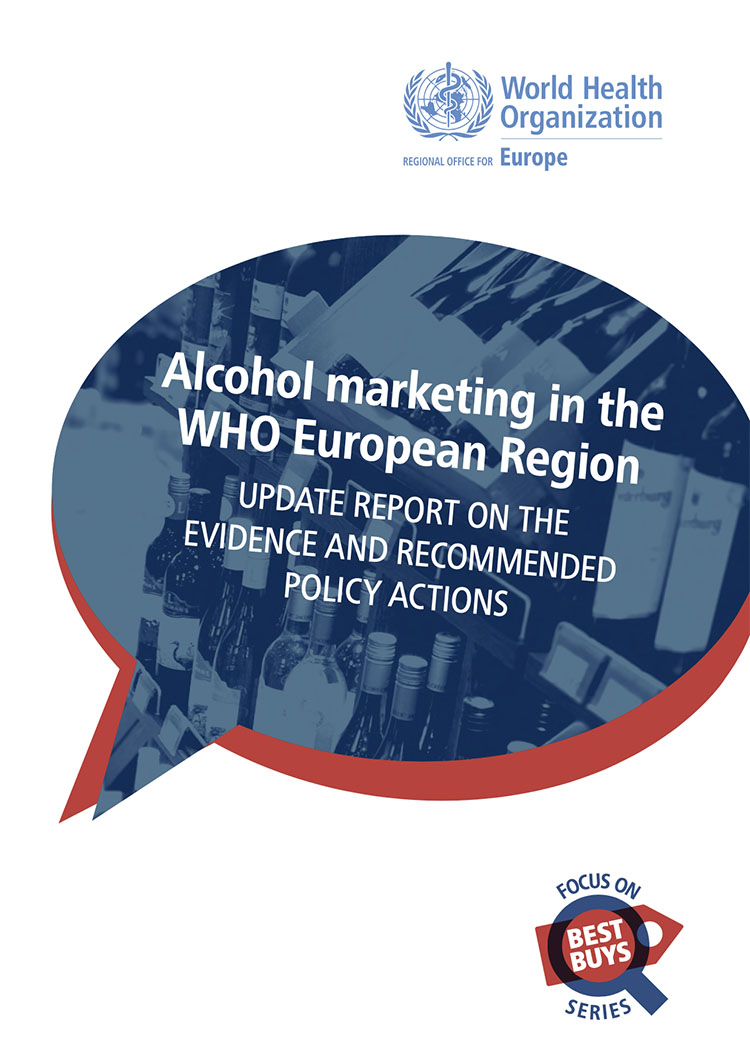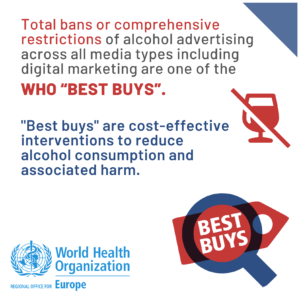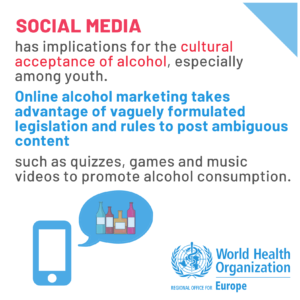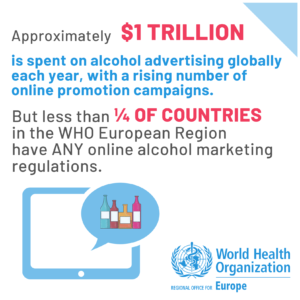New WHO Europe Report Shows Lack of Regulation Despite Growing Online Alcohol Marketing
Lack of regulation leaves door open to harmful digital marketing of alcohol, according to the new report “Alcohol marketing in the WHO European Region”. However, not all pricing policies are equal in their effectiveness or impact on alcohol harm and socioeconomic inequalities fueled by alcohol, says WHO Europe in the new report.
The new “update report on evidence and recommended policy actions” summarizes advances in the evidence and progress made since 2012 in the area of alcohol marketing in the WHO European Region. At the same time, it demonstrates the need for improved alcohol marketing policies that are capable of effectively regulating the quickly evolving digital marketing methodologies employed in the commercial sector to market alcoholic beverages.
 Key messages
Key messages
- Alcohol advertising and marketing is a massive and expanding phenomenon. Global expenditure on alcohol advertising is estimated to be US$ 1 trillion.
- The last decade has seen a shift from traditional marketing to digital landscapes. The new merged marketing channels, techniques and platforms make alcohol advertising a complex and ubiquitous phenomenon with multiple forms of expression.
- Exposure to alcohol advertising affects the alcohol consumption behaviour of children and young people; these groups must be protected from intrusive marketing messages.
According to a newly published report, alcohol marketing is adapting to new realities faster than current legal regulations across the WHO European Region, with the alcohol industry using opportunities offered by digital platforms to sell their products in a largely unregulated market. The new report explains how innovative online advertisement techniques can target consumers – including children and adolescents – precisely to promote alcohol use.
Inadequate policy response to growing online alcohol marketing
There has been a recent growth in citizens’ exposure to commercial messages, and the alcohol industry continues to increase spending on marketing. Approximately US$ 1 trillion is spent on alcohol advertising globally each year, with an ever-increasing number of promotional campaigns in online media; for example, two of the world’s largest alcohol producers – AB InBev and Diageo – report spending 15% of their annual global sales on marketing.
At the same time, according to the latest WHO data, less than a quarter of all Member States of the Region have at least some marketing bans for the internet. Even fewer countries have implemented similar restrictions for social media, despite bans or comprehensive restrictions of alcohol advertising being among the most cost-effective measures to reduce alcohol consumption and associated harms.
Although most countries of the Region have some form of marketing regulation, very few have statutory bans that prohibit or at least limit alcohol promotion, advertising and sponsorship.
In contrast to the work on tobacco control, there is no international or regional framework instrument with guidelines for implementation to underlay and support initiatives to regulate alcohol advertisement and promotion, including digital marketing. This is important since the available evidence suggests that alcohol industry self-regulation of their own marketing practices has no meaningful impact on public health and that investment in digital platforms has increased, targeting new consumers.
Existing regulation across the Region applies for the most part to traditional channels of marketing, such as advertising on television, radio and print media. It also remains largely fragmented, for instance prohibiting one type of alcoholic beverages for a certain media type, while not regulating others. Online marketing of alcohol is by far the least-regulated field, although a considerable shift has taken place from traditional channels to the digital landscape.
This situation needs to be changed, given that alcohol consumption levels in the WHO European Region are the world’s highest.
Alcohol marketing and alcohol harm
In 2016, every 10th death in the Region was attributed to alcohol.
Alcohol is not only a leading risk factor for noncommunicable diseases like cancer and heart conditions, but also contributes to a considerable number of infectious diseases, mental health issues, road traffic crashes, injuries, violent incidents and crimes.
Evidence suggests that exposure to alcohol marketing is associated with changes in alcohol-related knowledge, attitudes and behaviour, including among youth.
The association between exposure to alcohol marketing and levels of alcohol consumption and harm is well established, and this new WHO publication explains how countries of the Region can tackle the impact of evolving advertising techniques on people’s health.
With the help of new digital technology, companies can recruit consumers quickly and cheaply. The youngest users of digital platforms can be reached through app based social platforms. In these, native marketing blends into popular games or social media sites featuring vloggers and influencers.
Evidence points towards the fact that alcohol advertising exposure is positively associated with alcohol consumption behaviour, including among young people. A systematic review of studies covering 35,219 participants from Europe, Asia and North America, below the relevant minimum legal purchase age for alcohol showed a consistent correlation between marketing exposure and the level of youth alcohol consumption, including alcohol initiation as well as binge alcohol use.
Turning users into promoters
The last decade has seen a boom in online marketing technologies. Alcohol marketing is actively exploring the new grounds of the internet and social media, given that the existing legislation and rules for online platforms are vaguely formulated all over the Region.
According to the WHO report, the nature of social media communities has implications for the cultural acceptance of alcohol, especially among youth. New social media marketing interacts and engages, encouraging consumers to like posts, reply to questions, tag their friends and even generate their own content that serves the same promotional goals. In other words, social media users can unknowingly act as alcohol promoters themselves.
Alcohol marketing has become a global and multifactor issue. Today, it transcends borders and uses the diverse digital landscape to spread its messages. Online promotion techniques can even reach consumers in regions where alcohol-related content is prohibited by national law. The global scope of alcohol marketing, with blurred boundaries between advertiser and consumer, requires a broadening of the scope of marketing regulation and an update of current legislation, advises the WHO report.
Regulating alcohol marketing: what can the European Region do?
It is clear that action is urgently needed since existing legislation and codes of conduct do not match the changing nature of the advertising methods employed in the commercial sector. Social media and other online and app-based marketing techniques can, for example, reach consumers in regions where alcohol-related content is prohibited in national law.
When properly and efficiently enforced, alcohol marketing restrictions have been shown to constitute a cost-effective strategy for preventing and reducing alcohol harm, costing less than US$ 100 per healthy life year gained in low-income countries and less than US$ 500 in high-income countries.
The Region has opportunities to implement comprehensive, statutory regulations restricting or banning alcohol marketing to protect consumers and stop normalization of alcohol consumption behaviour for future generations.
Increased awareness of the extensive challenges posed by online marketing, and political commitment to deal with them, are needed more than ever. Digital marketing should be included in regulatory frameworks – as thousands of posts and videos are published on a multitude of platforms daily. There is an urgent need to develop a protocol to help distinguish native advertising, user-generated content and other commercial messages that may be difficult to understand or interpret, especially by younger consumers.
The positive side of global alcohol marketing campaigns is that they can unite countries. The Member States of the WHO European Region share common interests in producing knowledge and effective controls that can serve public health work across borders.
Policy options
- WHO suggests that bans or comprehensive restrictions on alcohol advertising are one of the top three most effective and cost-effective interventions to address the harmful use of alcohol. Digital marketing should be included in such regulatory frameworks.
- If a complete ban is not feasible, partial statutory restrictions on the content of posts published online should be implemented. In this case, sufficient resources should be earmarked for active supervision and robust enforcement of policies. As thousands of posts are published on a multitude of platforms daily, this is an extensive, yet crucial task.
- There is an urgent need to develop a protocol to help distinguish native advertising, user-generated content and other commercial messages that may be difficult to understand or interpret. The real senders of such material are likely to be invisible to consumers, especially young consumers and children.
- As many young people participate in social media milieus as a natural part of their everyday life, the very least a jurisdiction should do is to demand that alcohol brands properly enforce age verification (age-gating). Implementation of age limits on (for example) Facebook and Instagram pages is technically a small and straightforward matter. This is the least that should be expected to protect children and teenagers, and to ensure that underage users do not gain access to alcohol-related posts.
- Member States should take a consistent stance on the legal obligation of marketers to accurately tag media content and ensure that inappropriate content does not reach children.
The “Alcohol marketing in the WHO European Region” update report has been prepared by WHO/Europe’s Alcohol and Illicit Drugs Programme and the WHO European Office for the Prevention and Control of Noncommunicable Diseases.
—
For further reading from Movendi International’s Science Digest
Alcohol Marketing and Adolescent and Young Adult Alcohol Use Behaviors: A Systematic Review of Cross-Sectional Studies
Alcohol Marketing and Adolescent and Young Adult Alcohol Use Behaviors
Regulating Alcohol Marketing on Social Media: Outcomes and Limitations of Marketing Restrictions of Finland’s 2015 Alcohol Act
Regulating Alcohol Marketing on Social Media: Finnish Case Study


